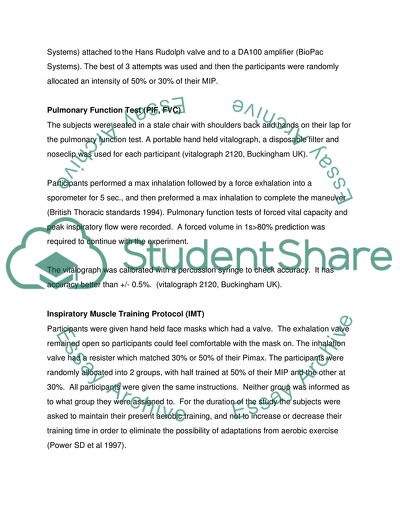
- Home
- Free Samples
- Premium Essays
- Editing Services
- Extra Tools
- Essay Writing Help
- About Us
- Studentshare
- Subjects
- Miscellaneous
- Its the metadology and intro to edit for dissertation
Its the metadology and intro to edit for dissertation - Essay Example
The inspiratory muscle strength was assed by…

- Subject: Miscellaneous
- Type: Essay
- Level: Undergraduate
- Pages: 4 (1000 words)
- Downloads: 0
- Author: rtremblay
Extract of sample "Its the metadology and intro to edit for dissertation"
The participants emptied their lungs to residual volume. Subjects were instructed to take their time to slowly empty their lungs. The subjects then were asked to perform a maximum inhalation effort through a breathing mask for 2/3 sec. A small hole was made to a covered resistive valve, to prevent closure of the glottis during expiration (M, Vitacca et el 2006). Inspiratory pressure was measured using a TSD140 pressure transducer (BioPac Systems) attached to the Hans Rudolph valve and to a DA100 amplifier (BioPac Systems).
The best of 3 attempts was used and then the participants were randomly allocated an intensity of 50% or 30% of their MIP. The subjects were seated in a stale chair with shoulders back and hands on their lap for the pulmonary function test. A portable hand held vitalograph, a disposable filter and noseclip was used for each participant (vitalograph 2120, Buckingham UK). Participants performed a max inhalation followed by a force exhalation into a sporometer for 5 sec., and then preformed a max inhalation to complete the maneuver (British Thoracic standards 1994).
Pulmonary function tests of forced vital capacity and peak inspiratory flow were recorded. A forced volume in 1s>80% prediction was required to continue with the experiment. Participants were given hand held face masks which had a valve. The exhalation valve remained open so participants could feel comfortable with the mask on. The inhalation valve had a resister which matched 30% or 50% of their Pimax. The participants were randomly allocated into 2 groups, with half trained at 50% of their MIP and the other at 30%.
All participants were given the same instructions. Neither group was informed as to what group they were assigned to. For the duration of the study the subjects were asked to maintain their present aerobic training, and not to increase or decrease their training time in order to
...Download file to see next pages Read MoreCHECK THESE SAMPLES OF Its the metadology and intro to edit for dissertation
Online Media in Shaping Gender Roles
Chlamydia trachomatis
Company Valuation Model and Application On Royal Bank of Scotland Plc
Large Family Businesses
The Impact of CCTV System in Curbing Theft
How the Implementation of Strategic IS Delivers Competitive Advantage in Tesco
Analysis of Shopping Habits in Supermarkets and their Impact on Evacuation Times
The Repercussions for International Companies if the UK Leaves the EU

- TERMS & CONDITIONS
- PRIVACY POLICY
- COOKIES POLICY